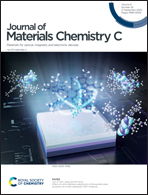Heavy Mn2+-doped near-infrared photon upconversion luminescence in fluoride RbZnF3:Yb3+,Mn2+ guided by dopant distribution simulation†
Abstract
Mn2+ ions-activated phosphors play a crucial role in modern lighting and display due to their typical tunable single-band visible (VIS) emission characteristics. Herein, besides the conventional VIS emission, a near-infrared (NIR) emission centered at ∼780 nm is presented in heavy Mn2+-doped fluoride RbZnF3:Yb3+,Mn2+ designed by the dopant-distribution prediction simulation. On varying the dopant (Mn2+) concentration, the single-band VIS emission to VIS/NIR dual emission and then to pure NIR photon upconversion (UC) emission was achieved in RbZnF3:Yb3+,Mn2+. The density functional theory (DFT) calculations, static and dynamic luminescence analysis, as well as the extended-X-ray absorption fine structure (EXAFS) characterization strongly confirmed that the NIR emission of the Mn2+ was from the Mn2+–Mn2+ dimer induced by Mn2+ ions aggregation in RbZnF3. Further, a ground-state absorption (GSA)/excited state absorption (ESA) NIR UC luminescence mechanism based on the Yb3+–Mn2+–Mn2+ trimer model is proposed. This work provides a new strategy for realizing single-band NIR photon UC emission, and also provides new insights into the rational design of the Mn2+ VIS/NIR emission via dopant-distribution prediction.



 Please wait while we load your content...
Please wait while we load your content...